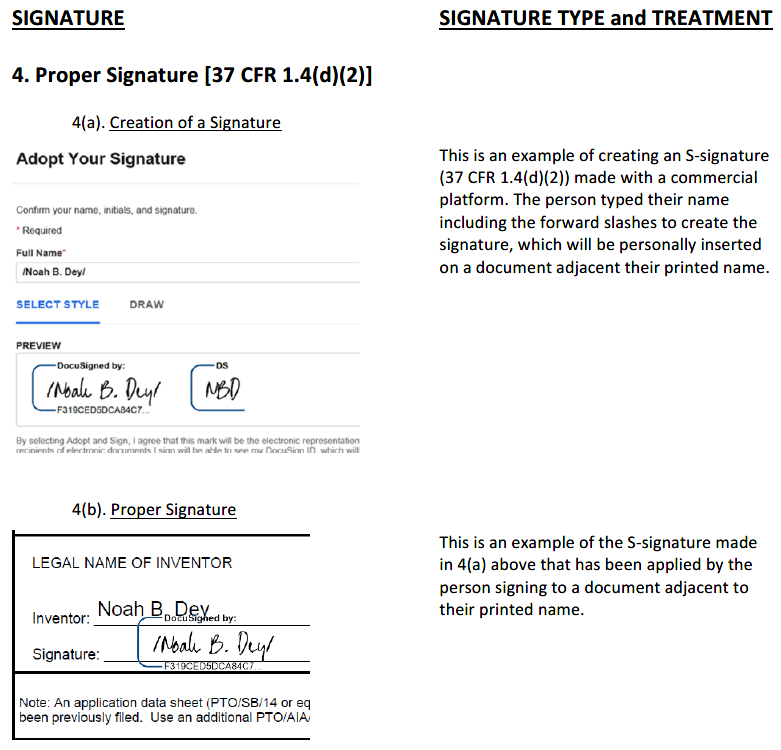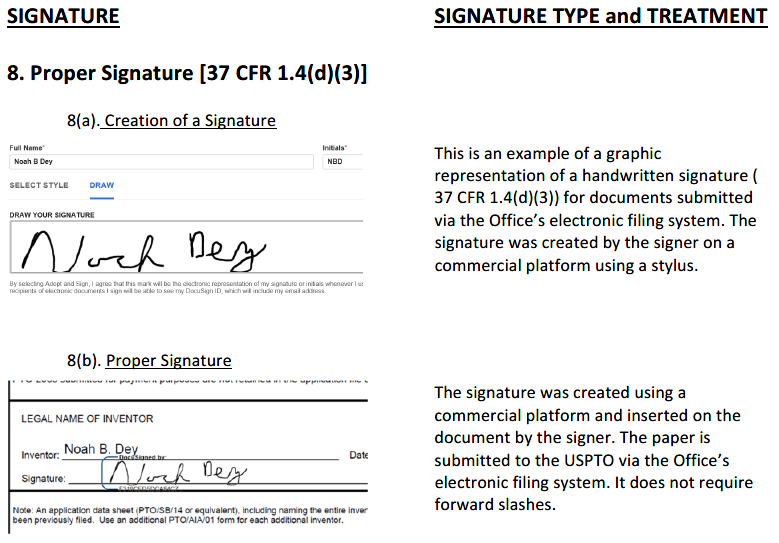The legal effect of electronic signatures varies from jurisdiction to jurisdiction, and the USPTO is no exception. 37 C.F.R. § 1.4(d)(1)–(3) govern the three acceptable forms of signatures for papers submitted to the USPTO: (i) handwritten signatures, (ii) S-signatures (e.g., /name/), and (iii) graphic representations of signatures.
In light of recent developments, there have been changes to the signing rules at the United States Patent and Trademark Office (USPTO). While wet ink signatures have traditionally been considered the gold standard, electronic signatures are now being recognized as an endorsed an effective alternative. The USPTO recently updated its guidance after roughly 16 years to accommodate the times. Below, we outline how to properly use electronic signatures at the USPTO.
When using electronic S-signatures
The signor must (i) personally type the S-signature (e.g., /Noah B Dey/) directly into the signature line or (ii) personally type their name into a commercial platform associated with the document. When using a commercial platform (e.g., DocuSign or Adobe), the final S-signature must have forward flanking slashes (e.g., /Noah B Dey/). The signor has the option of either a) typing a signature and the forward flanking slashes or b) typing a signature and then “applying” the personally typed signature in between a prepopulated set of forward slashes. The signor must be the one to type and apply the signature to the document. Some commercial platforms generate and apply bar codes next to the signature; this does not invalidate the electronic signature.
Further, the S-signature must be adjacent to the signor’s printed name. Additional forward slashes, improper characters (like question marks and exclamation marks), or graphic symbols (like happy faces) should not be used when signing with an S-signature. Thus, it is important to provide clear directions to people electronically signing documents when using electronic S-signatures—should they include the forward flanking slashes or not to avoid a double slash, which would be improper.
An example from the USPTO of a properly created and applied S-signature follows:

When using graphic representations of signatures
The signor must personally create the graphic representation of the signor’s handwritten signature on a commercial platform, often using a stylus or mouse, or finger. Optionally, a graphic representation can be applied by the signor directly on an electronic document without using a commercial platform (e.g., using a finger or stylus to sign on a touch screen of a smartphone). Unlike the S-signature, the signor need not include forward slashes, but, like the S-signature, the signor must be the one to personally apply the graphic representation onto the signature line adjacent to the printed name. As with the S-signature, bar codes generated and applied by the commercial platforms next to the graphic representation do not invalidate the electronic signature.
An example from the USPTO of a proper graphic representation of a signature follows:

Thus, the electronic signing of papers (e.g., inventor declarations) for submission to the USPTO (as described above) has finally been confirmed to be an effective alternative to wet signatures.


